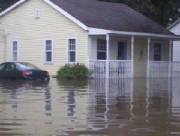|
All You Need To Know About Floods  Flood is one of the most common natural disasters that significantly affect our lives,
especially those who live in Florida's many flood-prone areas. Flood hazards can be local, affecting a small community or
locality or very large affecting multiple states or an entire country. Flood is one of the most common natural disasters that significantly affect our lives,
especially those who live in Florida's many flood-prone areas. Flood hazards can be local, affecting a small community or
locality or very large affecting multiple states or an entire country.
If
you live in a flood prone area or have been warned about an impending flood, then you should prepare as quickly as possible.
In order to prevent flood damage, you should take the necessary steps before, during and after the flood. Safety Tips To Minimise Flood Damage: - Elevate and reinforce your home to protect yourself and your property from flood hazards
- Elevate electric panel, water heater, furnace etc
- To
prevent flood water from blocking the drains of your home, sewer taps should be installed with appropriate check valves
- You should construct barriers like flood-walls, beams etc to prevent
flood water from entering into your building. This will help greatly to prevent flood damage
- You should also seal the walls of your basement with waterproofing compounds so as to avoid seepage
- Follow your local media and weather reports for warnings, evacuation instructions and flood
information
- If you have been warned of a flash flooding, try to move
to a higher ground as quickly as possible
- If you are preparing to
evacuate, then you should secure your home. If you have the time, move the valuables and essentials to an elevated place or
upper floor. You should also turn off all the utilities like power supply, water supply, gas supply etc at its main source.
Also disconnect all electrical appliances, if possible. This will help to prevent flood damage to the maximum extent possible
Safety Tips During A Flood: - If you have to move through water, always
walk through standing water.
- Check the firmness of the ground prior
to stepping with a stick and only then move on.
- Never walk through
moving water as it can make you fall
- It is very dangerous to drive in
the floods, as the flood water can easily sweep you and your car. If you are in the car and if you see the flood water rising,
then leave the car and move to a raised platform as quickly as possible
Safety Tips After The Flood: - Do no go back to your home as soon as the flood water recedes. You should go back to your home,
only when it is declared safe to return to the flooded areas
- Do not
turn on or start using utilities like power supply, water supply, gas supply etc immediately after a flood. Start using them
only after it is declared safe to use them or an electrician has checked them.
- Before starting living in your home and using your personal and household properties, you should clean, disinfect
and dry out them. This will also help to prevent flood damage to a great extent.
- Document and photograph all flood related damage
- If your property
sustained damage, contact a licensed Public Adjuster for damage assessment, insurance review and loss analysis
Flood Facts: - Floods are the most common and
widespread of all natural disasters outside of fire
- 90% of all presidential-declared U.S. natural
disasters involve flooding
- Floods occur within all 50 states (they can occur any time,
anywhere)
- Communities particularly at risk are those in low lying areas, coastal areas,
or downstream from large bodies of water
- 25% of flooding occurs outside areas formally
designated as being flood prone (i.e. Special Flood Hazard Areas)
- Nation-wide, flooding
caused more than $4 billion a year in losses and 2,200 deaths in the 1990's
- There is a
26% chance of experiencing a flood during the life of a 30 year mortgage (more than 6 times the likelihood of a fire)
- Even minor flooding can cost homeowners thousands of dollars in losses and repairs
- Flood damage is virtually never covered by standard homeowners insurance
- Flood
insurance purchased through the National Flood Insurance Program (NFIP) is relatively inexpensive (the average premium for
$100,000 coverage is a little over $300 per year at this writing)
- Today NFIP insures more
than 4 million policyholders in more than 19,000 communities in the U.S.
- Florida residents
and businesses hold more than 40% of all flood insurance policies in the nation
- Palm Beach
County has many programs to mitigate flood risks and assist residents before, during and after flood events
If you are living in a flood prone area, it is advisable to have flood insurance for your family
and property. This will help to reduce the cost of restoration after flood.
|





 Flood is one of the most common natural disasters that significantly affect our lives,
especially those who live in Florida's many flood-prone areas. Flood hazards can be local, affecting a small community or
locality or very large affecting multiple states or an entire country.
Flood is one of the most common natural disasters that significantly affect our lives,
especially those who live in Florida's many flood-prone areas. Flood hazards can be local, affecting a small community or
locality or very large affecting multiple states or an entire country.